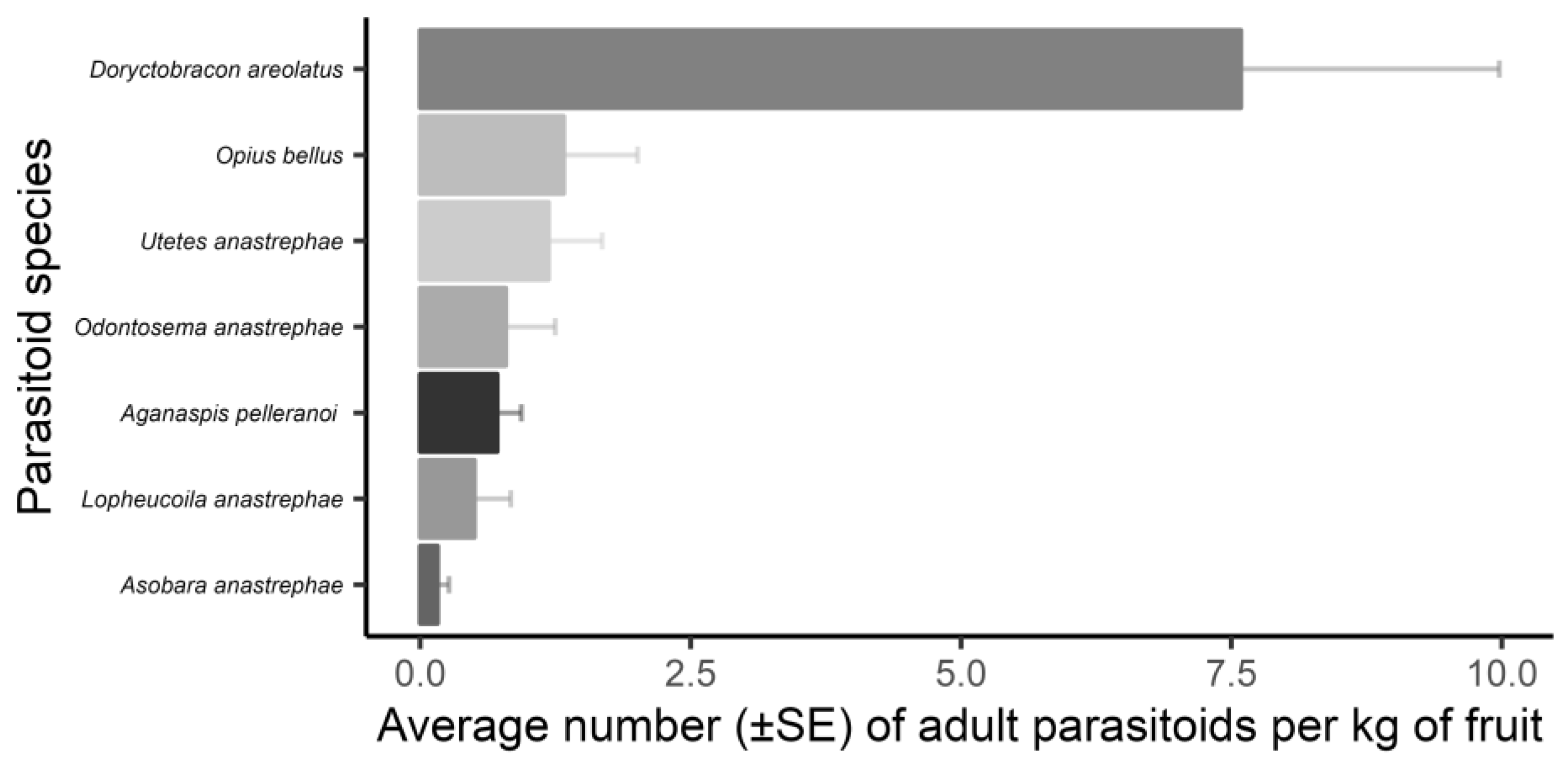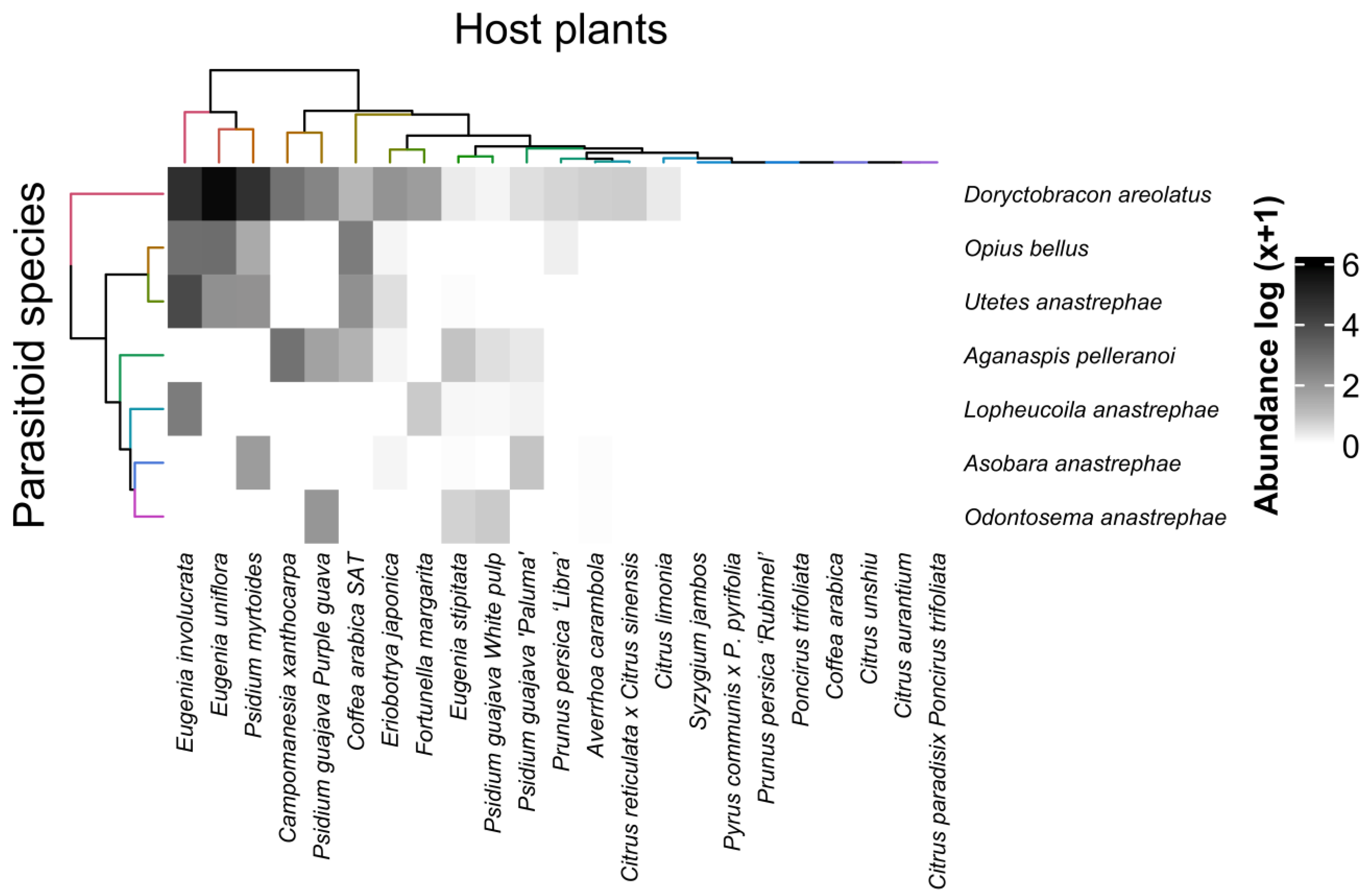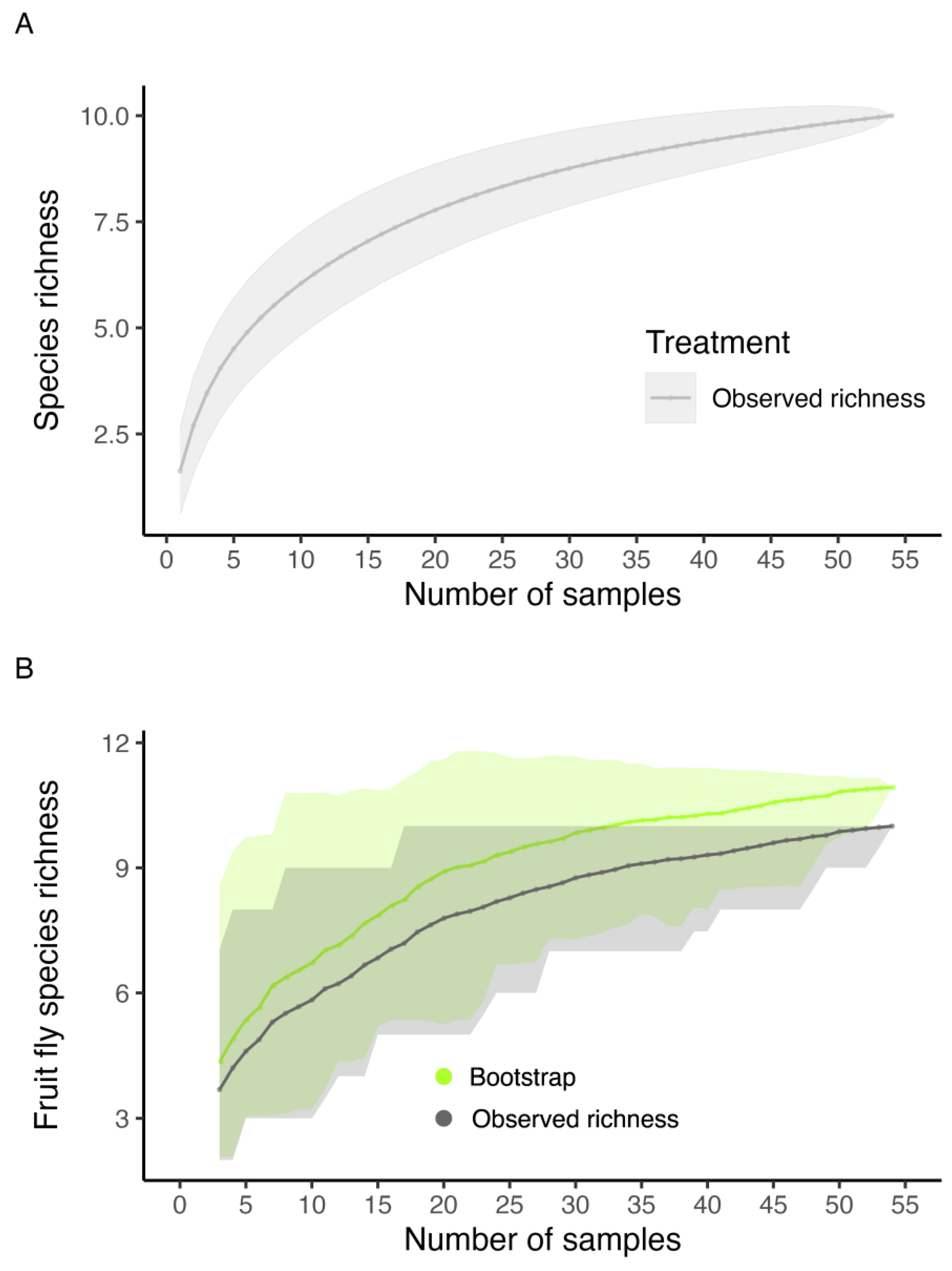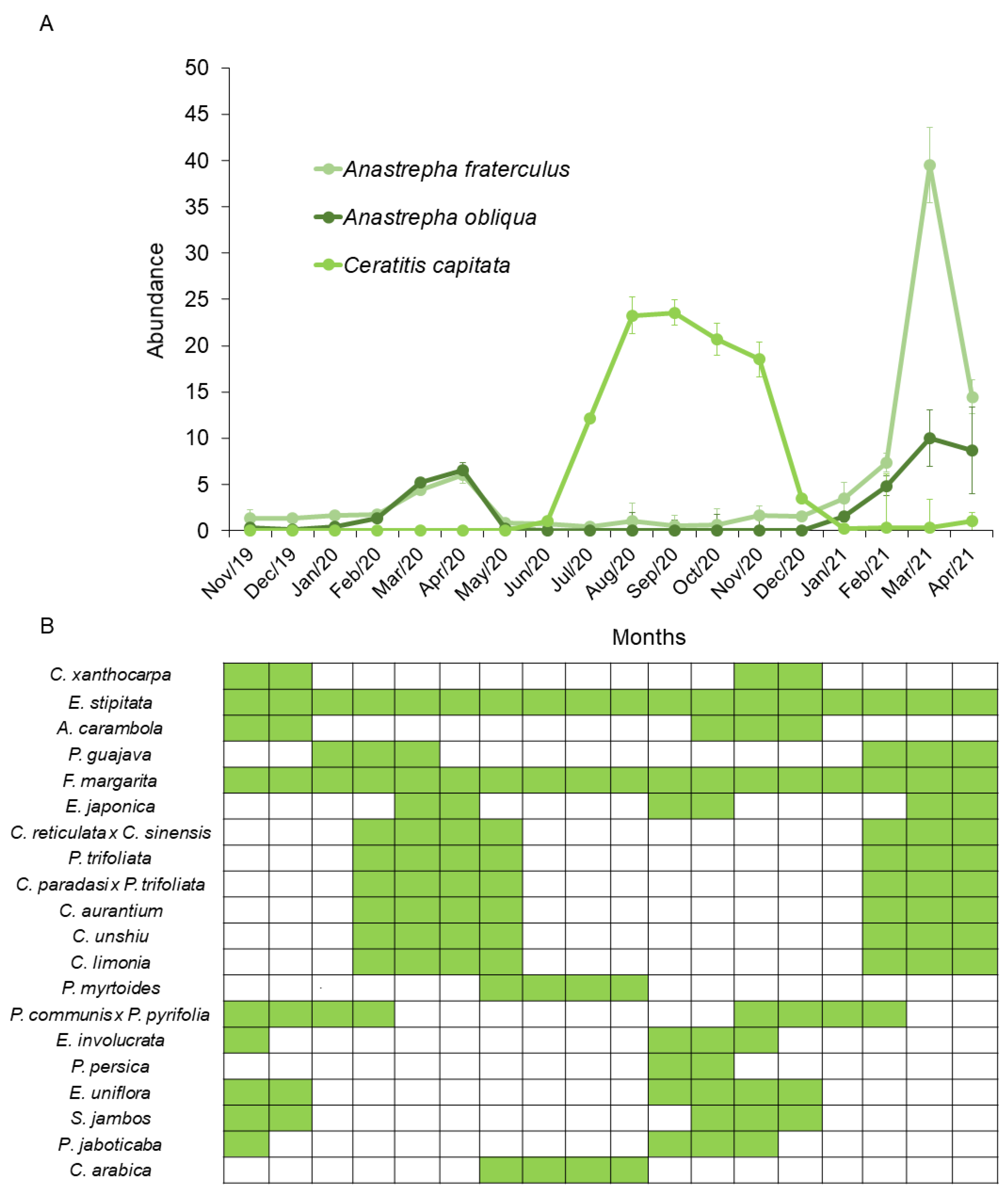Fruit Flies (Diptera: Tephritidae) in Minas Gerais, Brazil: Trophic Interactions and New Reports
Simple Summary
Abstract
1. Introduction
2. Materials and Methods
2.1. Study Area
2.2. Sampling
2.2.1. Fruit Collection
2.2.2. Traps
2.3. Identification of Insects
2.4. Data Analysis
2.5. Population Fluctuation
3. Results
3.1. Fruit Collection
3.1.1. Fruit Flies
3.1.2. Parasitoids
3.2. Traps
3.3. Population Fluctuation
4. Discussion
Supplementary Materials
Author Contributions
Funding
Data Availability Statement
Acknowledgments
Conflicts of Interest
References
- Abdala-Roberts, L.; Puentes, A.; Finke, D.L.; Marquis, R.J.; Montserrat, M.; Poelman, E.H.; Rasmann, S.; Sentis, A.; van Dam, N.M.; Wimp, G.; et al. Tri-trophic interactions: Bridging species, communities and ecosystems. Ecol. Lett. 2019, 22, 2151–2167. [Google Scholar] [CrossRef] [PubMed]
- Cunningham, J.P.; Carlsson, M.A.; Villa, T.F.; Dekker, T.; Clarke, A.R. Do fruit ripening volatiles enable resource specialism in polyphagous fruit flies? J. Chem. Ecol. 2016, 42, 931–940. [Google Scholar] [CrossRef] [PubMed]
- Ghosh, E.; Venkatesan, R. Plant volatiles modulate immune responses of Spodoptera litura. J. Chem. Ecol. 2019, 45, 715–724. [Google Scholar] [CrossRef] [PubMed]
- Bolton, L.G.; Piñero, J.C.; Barrett, B.A. Olfactory cues from host- and non-host plant odor influence the behavioral responses of adult Drosophila suzukii (Diptera: Drosophilidae) to visual cues. Environ. Entomol. 2021, 50, 571–579. [Google Scholar] [CrossRef]
- Jaleel, W.; Saeed, R.; Shabbir, M.Z.; Azad, R.; Ali, S.; Sial, M.U.; Aljedani, D.M.; Ghramh, H.A.; Khan, K.A.; Wang, D.; et al. Olfactory response of two different Bactrocera fruit flies (Diptera: Tephritidae) on banana, guava, and mango fruits. J. King Saud Univ. Sci. 2021, 33, 101455. [Google Scholar] [CrossRef]
- Drew, R.A.I.; Prokopy, R.J.; Romig, M.C. Attraction of fruit flies of the genus Bactrocera to colored mimics of host fruit. Entomol. Exp. Appl. 2023, 107, 39–45. [Google Scholar] [CrossRef]
- Rattanapun, W.; Amornsak, W.; Clarke, A.R. Bactrocera dorsalis preference for and performance on two mango varieties at three stages of ripeness. Entomol. Exp. Appl. 2009, 131, 243–253. [Google Scholar] [CrossRef]
- Yu, J.; Yang, W.; Zeng, X.; Liu, J. The oriental fruit fly Bactrocera dorsalis learns and remembers sugar quality. J. Insect Physiol. 2019, 117, 103895. [Google Scholar] [CrossRef]
- Anderson, P.; Anton, S. Experience-based modulation of behavioural responses to plant volatiles and other sensory cues in insect herbivores. Plant Cell Environ. 2014, 37, 1826–1835. [Google Scholar] [CrossRef]
- Kadow, I.C.G. State-dependent plasticity of innate behavior in fruit flies. Curr. Opin. Neurobiol. 2019, 54, 60–65. [Google Scholar] [CrossRef]
- Cai, P.; Song, Y.; Huo, D.; Lin, J.; Zhang, H.; Zhang, Z.; Xiao, C.; Huang, F.; Ji, Q. Chemical cues induced from fly-oviposition mediate the host-seeking behaviour of Fopius arisanus (Hymenoptera: Braconidae), an effective egg parasitoid of Bactrocera dorsalis (Diptera: Tephritidae), within a tritrophic context. Insects 2020, 11, 231. [Google Scholar] [CrossRef] [PubMed]
- Ayelo, P.M.; Pirk, C.W.; Yusuf, A.A.; Chailleux, A.; Mohamed, S.A.; Deletre, E. Exploring the kairomone-based foraging behaviour of natural enemies to enhance biological control: A Review. Front. Ecol. Evol. 2021, 9, 143. [Google Scholar] [CrossRef]
- Zida, I.; Nacro, S.; Dabiré, R.A.; Moquet, L.; Haran, J.; Delatte, H. Native hymenopteran parasitoids associated with fruit-infesting flies in three plant formations and prospects for biological control in Western Burkina Faso, West Africa. Agric. Forest Entomol. 2022, 24, 114–123. [Google Scholar] [CrossRef]
- Pires, P.D.S.; Sant’ Ana, J.; Redaelli, L.R.; Leite, N.A. Chemotaxis and parasitism of the Neotropical fruit fly parasitoid Ganaspis pelleranoi can be altered by pre-imaginal and imaginal conditioning to fruit volatiles. Entomol. Exp. Appl. 2022, 170, 419–426. [Google Scholar] [CrossRef]
- Paranhos, B.J.; Nava, D.E.; Malavasi, A. Biological control of fruit flies in Brazil. Pesq. Agropeq. Bras. 2019, 54, e26037. [Google Scholar] [CrossRef]
- Clarke, A.R.; Harris, C.; Kay, B.J.; Mainali, B.P.; McLay, L.K.; Strutt, F.; Cunningham, J.P. Opiine parasitoids (Hymenoptera: Braconidae) and biological control of fruit flies (Diptera: Tephritidae) in Australia: Past, present and future. Ann. Appl. Biol. 2022, 180, 44–72. [Google Scholar] [CrossRef]
- Dias, N.P.; Montoya, P.; Nava, D.E. A 30-year systematic review reveals success in tephritid fruit fly biological control research. Entomol. Exp. Appl. 2022, 170, 370–384. [Google Scholar] [CrossRef]
- Zucchi, R.A.; Moraes, R.C.B. Fruit Flies in Brazil—Anastrepha Species Their Host Plants and Parasitoids. 2024. Available online: http://www.lea.esalq.usp.br/anastrepha (accessed on 23 January 2024).
- Deschepper, P.; Todd, T.N.; Virgilio, M.; De Meyer, M.; Barr, N.B.; Ruiz-Arce, R. Looking at the big picture: Worldwide population structure and range expansion of the cosmopolitan pest Ceratitis capitata (Diptera, Tephritidae). Biol. Invasions 2021, 23, 3529–3543. [Google Scholar] [CrossRef]
- Zucchi, R.A.; Moraes, R.C.B. Fruit Flies in Brazil—Hosts and Parasitoids of the Mediterranean Fruit Fly. 2024. Available online: http://www.lea.esalq.usp.br/ceratitis (accessed on 23 January 2024).
- Almeida, L.B.M.; Coelho, J.B.; Guimarães, J.A.; Uchoa, M.A. Native parasitoids (Hymenoptera: Braconidae) of fruit flies (Diptera: Tephritidae) in Serra da Bodoquena National Park-MS, Brazil. Biota Neotrop. 2019, 19, 20190776. [Google Scholar] [CrossRef]
- De Sousa, M.D.S.M.; dos Santos, J.E.V.; de Toledo, J.J.; Nava, D.E.; Adaime, R. Geissospermum argenteum (Angiosperma: Apocynaceae): A reservoir of parasitoids of fruit flies (Diptera: Tephritidae) in an upland forest in the Brazilian Amazon. Agric. Forest Entomol. 2021, 23, 297–310. [Google Scholar] [CrossRef]
- De Sousa, M.D.S.M.; Dos Santos, J.E.V.; Edson Nava, D.; Zucchi, R.A.; Adaime, R. Overview and checklist of parasitoids (Hymenoptera, Braconidae and Figitidae) of Anastrepha fruit flies (Diptera, Tephritidae) in the Brazilian Amazon. Ann. Res. Rev. Biol. 2021, 36, 60–74. [Google Scholar] [CrossRef]
- Alvarenga, C.D.; Matrangolo, C.A.R.; Lopes, G.N.; Silva, M.A.; Lopes, E.N.; Alves, D.A.; Nascimento, A.S.; Zucchi, R.A. Moscas-das-frutas (Diptera: Tephritidae) e seus parasitóides em plantas hospedeiras de três municípios do norte do Estado de Minas Gerais. Arq. Inst. Biol. 2009, 76, 195–204. [Google Scholar] [CrossRef]
- Querino, R.B.; Maia, J.B.; Lopes, G.N.; Alvarenga, C.D.; Zucchi, R.A. Fruit fly (Diptera: Tephritidae) community in guava orchards and adjacent fragments of native vegetation in Brazil. Fla. Entomol. 2014, 97, 778–786. [Google Scholar] [CrossRef]
- Camargos, M.G.; Alvarenga, C.D.; Giustolin, T.A.; Oliveira, P.C.D.C.; Rabelo, M.M. Moscas-das-frutas (Diptera: Tephritidae) em cafezais irrigados no norte de Minas Gerais. Coffee Sci. 2015, 10, 28–37. [Google Scholar]
- Soares, D.P.; Souza, T.A.N.D.; Santos, J.D.O.; Giustolin, T.A.; Alvarenga, C.D. Fruit flies (Diptera: Tephritidae) in mango orchards in the Minas Gerais Semi-arid region. Rev. Caatinga 2020, 33, 844–852. [Google Scholar] [CrossRef]
- Pirovani, V.D.; Martins, D.S.; Uramoto, K.; Ferreira, P.S.F. New occurrences of Anastrepha Schiner (Diptera: Tephritidae) in the state of Minas Gerais, Brazil. Arq. Inst. Biol. 2020, 87, e0342019. [Google Scholar] [CrossRef]
- Rossi, M.M.; Matioli, J.C.; Bueno, V.H.P. Principais espécies de moscas-das-frutas (Diptera: Tephritidae) e sua dinâmica populacional em pessegueiros na região de Caldas, Sul de Minas Gerais. Rev. Agric. 1998, 63, 329–342. [Google Scholar]
- Alvares, C.A.; Stape, J.L.; Sentelhas, P.C.; Gonçalves, J.D.M.; Sparovek, G. Köppen’s climate classification map for Brazil. Meteorol. Z. 2013, 22, 711–728. [Google Scholar] [CrossRef]
- Coelho, R.S. (Department of Entomology, Federal University of Lavras, Lavras, Minas Gerais, Brazil). Description of the Experimental Orchard of the Federal University of Lavras—UFLA, Minas Gerais, Brazil. Personal communication, 2019.
- Uramoto, K. Diversidade de moscas-das-frutas (Diptera: Tephritidae) em pomares comerciais de papaia e em áreas remanescentes da Mata Atlântica e suas plantas hospedeiras nativas, no município de Linhares, Espírito Santo. Ph.D. Thesis, Escola Superior de Agricultura Luiz de Queiroz, Universidade de São Paulo, Piracicaba, Brazil, 2007. [Google Scholar]
- Zucchi, R.A.; Silva, R.A.; Deus, E.G. Espécies de Anastrepha e seus hospedeiros na Amazônia brasileira. In Moscas-das-Frutas na Amazônia Brasileira: Diversidade, Hospedeiros e Inimigos Naturais; Silva, R.A., Lemos, W.A., Zucchi, R.A., Eds.; Embrapa: Macapá, Amapá, Brasil, 2011; pp. 51–70. [Google Scholar]
- Canal, N.A.; Zucchi, R.A. Parasitóides—Braconidae. In Moscas-das-Frutas de Importância Econômica no Brasil: Conhecimento Básico e Aplicado; Malavasi, A., Zucchi, R.A., Eds.; Holos-FAPESP: São Paulo, Brasil, 2000; pp. 119–126. [Google Scholar]
- Marinho, C.F.; Costa, V.A.; Zucchi, R.A. Annotated checklist and illustrated key to braconid parasitoids (Hymenoptera, Braconidae) of economically important fruit flies (Diptera, Tephritidae) in Brazil. Zootaxa 2018, 4527, 21–36. [Google Scholar] [CrossRef]
- Guimarães, J.A.; Gallardo, F.E.; Díaz, N.B.; Zucchi, R.A. Eucoilinae species (Hymenoptera: Cynipoidea: Figitidae) parasitoids of fruit-infesting dipterous larvae in Brazil: Identity, geographical distribution and host associations. Zootaxa 2003, 278, 1–23. [Google Scholar] [CrossRef]
- R Core Team. R: A Language and Environment for Statistical Computing. R Foundation for Statistical Computing: Vienna, Austria, 2020; Available online: https://www.R-project.org/ (accessed on 11 July 2022).
- Oksanen, F.J.; Blanchet, G.; Friendly, M. Vegan: Community Ecology Package: R Package Version 2.5-7. 2020. Available online: https://CRAN.R-project.org/package=vegan (accessed on 30 June 2022).
- Araujo, M.R.; Uramoto, K.; Ferreira, E.N.L.; Mesquita Filho, W.; Walder, J.M.M.; Savaris, M.; Zucchi, R.A. Fruit fly (Diptera: Tephritidae) diversity and host relationships in diverse environments estimated with two sampling methods. Environ. Entomol. 2019, 48, 227–233. [Google Scholar] [CrossRef] [PubMed]
- Aluja, M.; Guillén, L.; Castro, Á.; Cárdenas, M.L.; Hurtado, M.; Durán, Ó.; Arévalo-Peñaranda, E. Physalis peruviana L. (Solanaceae) is not a host of Ceratitis capitata (Diptera: Tephritidae): Evidence from multi-year field and laboratory studies in Colombia. Insects 2019, 10, 434. [Google Scholar] [CrossRef] [PubMed]
- Montoya, P.; Ayala, A.; López, P.; Cancino, J.; Cabrera, H.; Cruz, J.; Martinez, A.M.; Figueroa, I.; Liedo, P. Natural parasitism in fruit fly (Diptera: Tephritidae) populations in disturbed areas adjacent to commercial mango orchards in Chiapas and Veracruz, Mexico. Environ. Entomol. 2016, 45, 328–337. [Google Scholar] [CrossRef]
- López-Ortega, M.; Díaz-Fleischer, F.; Piñero, J.C.; Valdez-Lazalde, J.R.; Hernández-Ortiz, M.; Hernández-Ortiz, V. The mayan tropical rainforest: An uncharted reservoir of tritrophic host-fruit fly-parasitoid interactions. Insects 2020, 11, 495. [Google Scholar] [CrossRef]
- Aluja, M.; Ovruski, S.M.; Sivinski, J.; Córdova-García, G.; Schliserman, P.; Nuñez-Campero, S.R.; Ordano, M. Inter-specific competition and competition-free space in the tephritid parasitoids Utetes anastrephae and Doryctobracon areolatus (Hymenoptera: Braconidae: Opiinae). Ecol. Entomol. 2013, 38, 485–496. [Google Scholar] [CrossRef]
- Harbi, A.; Beitia, F.; Ferrara, F.; Chermiti, B.; Sabater-Munoz, B. Functional response of Diachasmimorpha longicaudata (Ashmead) over Ceratitis capitata (Wiedemann): Influence of temperature, fruit location and host density. Crop Protec. 2018, 109, 115–122. [Google Scholar] [CrossRef]
- Silva, D.R.D.B.; Roriz, A.K.P.; Petitinga, C.S.C.D.A.; Lima, I.V.G.; do Nascimento, A.S.; Joachim-Bravo, I.S. Competitive interactions and partial displacement of Anastrepha obliqua by Ceratitis capitata in the occupation of host mangoes (Mangifera indica). Agric. Forest Entomol. 2021, 23, 70–78. [Google Scholar] [CrossRef]








| Hosts | Fruit Fly Species (Females) | Fruit Fly (Males) | Sampled Fruits (n) |
|---|---|---|---|
| Family/Species | |||
| Myrtaceae | |||
| Eugenia stipitata | Anastrepha fraterculus (Wied.) (177) | 699 | 1373 |
| Anastrepha obliqua (Macquart) (496) | |||
| Ceratitis capitata (Wied.) (1) | 0 | ||
| Psidium myrtoides | Anastrepha bistrigata Bezzi (58) | 198 | 442 |
| Anastrepha fraterculus (Wied.) (178) | |||
| Anastrepha obliqua (Macquart) (2) | |||
| Ceratitis capitata (Wied.) (2) | 4 | ||
| Campomanesia xanthocarpa | Anastrepha fraterculus (Wied.) (6) | 1 | 7 |
| Psidium guajava White pulp | Anastrepha bistrigata Bezzi (9) | 152 | 291 |
| Anastrepha fraterculus (Wied.) (66) | |||
| Anastrepha obliqua (Macquart) (64) | |||
| Psidium guajava White pulp a | Anastrepha fraterculus (Wied.) (25) | 19 | 52 |
| Anastrepha obliqua (Macquart) (7) | |||
| Anastrepha bistrigata Bezzi (1) | |||
| Psidium guajava ‘Paluma’ | Anastrepha bistrigata Bezzi (5) | 34 | 79 |
| Anastrepha fraterculus (Wied.) (36) | |||
| Anastrepha obliqua (Macquart) (4) | |||
| Psidium guajava Purple guava | Anastrepha bistrigata Bezzi (17) | 172 | 377 |
| Anastrepha fraterculus (Wied.) (162) | |||
| Anastrepha obliqua (Macquart) (26) | |||
| Plinia jaboticaba | Anastrepha fraterculus (Wied.) (1) | 1 | 2 |
| Eugenia involucrata | Anastrepha fraterculus (Wied.) (110) | 107 | 222 |
| Ceratitis capitata (Wied.) (2) | 3 | ||
| Syzygium jambos | Anastrepha fraterculus (Wied.) (5) | 3 | 16 |
| Ceratitis capitata (Wied.) (0) | 8 | ||
| Eugenia uniflora | Anastrepha fraterculus (Wied.) (99) | 128 | 232 |
| Anastrepha obliqua (Macquart) (1) | |||
| Ceratitis capitata (Wied.) (3) | 1 | ||
| Eugenia uniflora a | Anastrepha fraterculus (Wied.) (31) | 35 | 66 |
| Eugenia pyriformis a | Anastrepha obliqua (Macquart) (53) | 31 | 84 |
| Rubiaceae | |||
| Coffea arabica | Anastrepha fraterculus (Wied.) (3) | 0 | 31 |
| Anastrepha obliqua (Macquart) (1) | |||
| Ceratitis capitata (Wied.) (12) | 15 | ||
| Coffea arabica SAT c | Anastrepha fraterculus (Wied.) (77) | 83 | 167 |
| Ceratitis capitata (Wied.) (4) | 3 | ||
| Oxalidaceae | |||
| Averrhoa carambola | Anastrepha fraterculus (Wied.) (6) | 138 | 422 |
| Anastrepha obliqua (Macquart) (263) | |||
| Ceratitis capitata (Wied.) (7) | 8 | ||
| Rutaceae | |||
| Citrus paradisi × Poncirus trifoliata | Anastrepha fraterculus (Wied.) (2) | 1 | 3 |
| Citrus reticulata × Citrus sinensis | Anastrepha fraterculus (Wied.) (6) | 4 | 11 |
| Anastrepha obliqua (Macquart) (1) | |||
| Citrus aurantium | Anastrepha fraterculus (Wied.) (1) | 2 | 3 |
| Citrus sinensis b | Anastrepha fraterculus (Wied.) (4) | 2 | 6 |
| Fortunella margarita | Anastrepha obliqua (Macquart) (2) | 10 | 78 |
| Ceratitis capitata (Wied.) (49) | 17 | ||
| Citrus limonia | Anastrepha fraterculus (Wied.) (6) | 7 | 13 |
| Poncirus trifoliata | Anastrepha fraterculus (Wied.) (3) | 1 | 4 |
| Citrus unshiu | Anastrepha fraterculus (Wied.) (9) | 7 | 16 |
| Rosaceae | |||
| Eriobotrya japonica | Anastrepha fraterculus (Wied.) (173) | 217 | 486 |
| Anastrepha obliqua (Macquart) (23) | |||
| Anastrepha bahiensis Lima (1) | |||
| Ceratitis capitata (Wied.) (6) | 66 | ||
| Pyrus communis × P. pyrifolia | Anastrepha fraterculus (Wied.) (9) | 15 | 32 |
| Ceratitis capitata (Wied.) (3) | 5 | ||
| Prunus persica ‘Libra’ | Anastrepha fraterculus (Wied.) (52) | 48 | 1124 |
| Ceratitis capitata (Wied.) (496) | 528 | ||
| Prunus persica ‘Rubimel’ | Anastrepha fraterculus (Wied.) (5) | 4 | 25 |
| Ceratitis capitata (Wied.) (8) | 8 |
| Species of Parasitoids | Number | Associated Plants | Host Fruit Flies |
|---|---|---|---|
| Aganaspis pelleranoi (Brèthes) | 31 | Eugenia stipitata | A. fraterculus, A. obliqua, C. capitata |
| 2 | Campomanesia xanthocarpa | A. fraterculus | |
| 6 | Psidium guajava White pulp | A. bistrigata, A. fraterculus, A. obliqua | |
| 2 | P. guajava ‘Paluma’ | A. bistrigata, A. fraterculus, A. obliqua | |
| 32 | P. guajava Purple guava | A. bistrigata, A. fraterculus, A. obliqua | |
| 8 | Coffea arabica SAT b | A. fraterculus, C. capitata | |
| Doryctobracon areolatus (Szépligeti) | 7 | E. stipitata | A. fraterculus, A. obliqua, C. capitata |
| 344 | Psidium myrtoides | A. bistrigata, A. fraterculus, A. obliqua, C. capitata | |
| 2 | C. xanthocarpa | A. fraterculus | |
| 2 | P. guajava White pulp | A. bistrigata, A. fraterculus, A. obliqua | |
| 3 | P. guajava ‘Paluma’ | A. bistrigata, A. fraterculus, A. obliqua | |
| 73 | P. guajava Purple guava | A. bistrigata, A. fraterculus, A. obliqua | |
| 35 | Eugenia involucrata | A. fraterculus, C. capitata | |
| 133 | Eugenia uniflora | A. fraterculus, A. obliqua, C. capitata | |
| 48 | Eugenia uniflora a | A. fraterculus | |
| 1 | Eugenia pyriformis a | A. obliqua | |
| 7 | C. arabica SAT b | A. fraterculus, C. capitata | |
| 40 | Averrhoa carambola | A. fraterculus, A. obliqua, C. capitata | |
| 7 | Citrus reticulate × Citrus sinensis | A. fraterculus, A. obliqua | |
| 8 | Fortunella margarita | A. obliqua, C. capitata | |
| 1 | Citrus limonia | A. fraterculus | |
| 43 | Eriobotrya japonica | A. fraterculus, A. obliqua, A. bahiensis, C. capitata | |
| 3 | Prunus persica ‘Libra’ | A. fraterculus, C. capitata | |
| Lopheucoila anastrephae (Rhower) | 3 | E. stipitata | A. fraterculus, A. obliqua, C. capitata |
| 1 | P. guajava White pulp | A. bistrigata, A. fraterculus, A. obliqua | |
| 1 | P. guajava ‘Paluma’ | A. bistrigata, A. fraterculus, A. obliqua | |
| 4 | E. involucrata | A. fraterculus, C. capitata | |
| 2 | F. margarita | A. obliqua, C. capitata | |
| Odontosema anastrephae Borgmeier | 21 | E. stipitata | A. fraterculus, A. obliqua, C. capitata |
| 12 | P. guajava White pulp | A. bistrigata, A. fraterculus, A. obliqua | |
| 45 | P. guajava Purple guava | A. bistrigata, A. fraterculus, A. obliqua | |
| 1 | A. carambola | A. fraterculus, A. obliqua, C. capitata | |
| Opius bellus Grahan | 11 | P. myrtoides | A. bistrigata, A. fraterculus, A. obliqua, C. capitata |
| 6 | E. involucrata | A. fraterculus, C. capitata | |
| 8 | E. uniflora | A. fraterculus, A. obliqua, C. capitata | |
| 6 | E. uniflora a | A. fraterculus | |
| 38 | C. arabica SAT b | A. fraterculus, C. capitata | |
| 1 | E. japonica | A. fraterculus, A. obliqua, A. bahiensis, C. capitata | |
| 1 | P. persica ‘Libra’ | A. fraterculus, C. capitata | |
| Utetes anastrephae (Viereck) | 1 | E. stipitata | A. fraterculus, A. obliqua, C. capitata |
| 23 | P. myrtoides | A. bistrigata, A. fraterculus, A. obliqua, C. capitata | |
| 16 | E. involucrata | A. fraterculus, C. capitata | |
| 3 | E. uniflora | A. fraterculus, A. obliqua, C. capitata | |
| 8 | E. uniflora a | A. fraterculus | |
| 22 | C. arabica SAT b | A. fraterculus, C. capitata | |
| 4 | E. japonica | A. fraterculus, A. obliqua, A. bahiensis, C. capitata | |
| Asobara anastrephae (Muesebeck) | 1 | E. stipitata | A. fraterculus, A. obliqua, C. capitata |
| 17 | P. myrtoides | A. bistrigata, A. fraterculus, A. obliqua, C. capitata | |
| 7 | P. guajava ‘Paluma’ | A. bistrigata, A. fraterculus, A. obliqua | |
| 2 | A. carambola | A. fraterculus, A. obliqua, C. capitata | |
| 1 | E. japonica | A. fraterculus, A. obliqua, A. bahiensis, C. capitata |
| Hosts | Parasitism (%) | Mean Parasitism (%) 1 | |
|---|---|---|---|
| Family/Species | Tree | Ground | |
| Myrtaceae | |||
| Eugenia stipitata | 1.29 | 3.99 | 2.84 |
| Psidium myrtoides | 32.73 | 61.86 | 40.4 |
| Campomanesia xanthocarpa | 0 | 80 | 40 |
| Psidium guajava White pulp | 0.71 | 13.65 | 7.18 |
| P. guajava Whitepulp a | 0 | 0 | 0 |
| P. guajava Purple guava | 21.02 | 37.5 | 28.51 |
| Plinia jaboticaba | 0 | 0 | 0 |
| Eugenia involucrata | 15.37 | 40.9 | 27 |
| Syzygium jambos | 0 | 0 | 0 |
| Eugenia uniflora | 36.66 | 38.81 | 37.73 |
| E. uniflora a | 40.54 | 59.25 | 49.89 |
| Eugenia pyriformis | 0.9 | 0 | 0.45 |
| Rutaceae | |||
| Citrus paradisi × Poncirus trifoliata | 0 | 0 | 0 |
| Citrus sinensis | 0 | 0 | 0 |
| Fortunella margarita | 0.55 | 54.68 | 30.62 |
| Citrus limonia | 0 | 7.14 | 3.57 |
| Poncirus trifoliata | 0 | 0 | 0 |
| Citrus unshiu | 0 | 0 | 0 |
| Rubiaceae | |||
| Coffea arabica | 0 | - | 0 |
| C. arabica SAT b | 31.4 | - | 31.4 |
| Oxalidaceae | |||
| Averrhoa carambola | 6.96 | 7.09 | 7.02 |
| Rosaceae | |||
| Eriobotrya japonica | 13.65 | 9.55 | 11.6 |
| Pyrus communis × P. pyrifolia | 0 | 0 | 0 |
| Prunus persica ‘Libra’ | 0.3 | 0.28 | 0.19 |
| P. persica ‘Rubimel’ | 0 | 0 | 0 |
| Species | Females (n) | Collections (n) | Relative Frequency |
|---|---|---|---|
| Ceratitis capitata | 880 | 22 | 0.498 |
| Anastrepha fraterculus | 600 | 45 | 0.339 |
| Anastrepha obliqua | 255 | 24 | 0.144 |
| Anastrepha distincta | 11 | 8 | 0.006 |
| Anastrepha grandis | 7 | 7 | 0.004 |
| Anastrepha chiclayae | 6 | 4 | 0.003 |
| Anastrepha bistrigata | 4 | 4 | 0.002 |
| Anastrepha pseudoparallela | 3 | 2 | 0.002 |
| Anastrepha amita | 1 | 1 | 0.001 |
| Anastrepha punctata | 1 | 1 | 0.001 |
| Total | 1768 | ||
| Richness S’ | 10 |
Disclaimer/Publisher’s Note: The statements, opinions and data contained in all publications are solely those of the individual author(s) and contributor(s) and not of MDPI and/or the editor(s). MDPI and/or the editor(s) disclaim responsibility for any injury to people or property resulting from any ideas, methods, instructions or products referred to in the content. |
© 2024 by the authors. Licensee MDPI, Basel, Switzerland. This article is an open access article distributed under the terms and conditions of the Creative Commons Attribution (CC BY) license (https://creativecommons.org/licenses/by/4.0/).
Share and Cite
Coelho, R.S.; Alvarenga, C.; Pec, M.; Rodrigues-Silva, A.L.; Peche, P.M.; Alves, E.; Marucci, R. Fruit Flies (Diptera: Tephritidae) in Minas Gerais, Brazil: Trophic Interactions and New Reports. Insects 2025, 16, 17. https://doi.org/10.3390/insects16010017
Coelho RS, Alvarenga C, Pec M, Rodrigues-Silva AL, Peche PM, Alves E, Marucci R. Fruit Flies (Diptera: Tephritidae) in Minas Gerais, Brazil: Trophic Interactions and New Reports. Insects. 2025; 16(1):17. https://doi.org/10.3390/insects16010017
Chicago/Turabian StyleCoelho, Rosamara Souza, Clarice Alvarenga, Marvin Pec, Ana Luisa Rodrigues-Silva, Pedro Maranha Peche, Emanoel Alves, and Rosangela Marucci. 2025. "Fruit Flies (Diptera: Tephritidae) in Minas Gerais, Brazil: Trophic Interactions and New Reports" Insects 16, no. 1: 17. https://doi.org/10.3390/insects16010017
APA StyleCoelho, R. S., Alvarenga, C., Pec, M., Rodrigues-Silva, A. L., Peche, P. M., Alves, E., & Marucci, R. (2025). Fruit Flies (Diptera: Tephritidae) in Minas Gerais, Brazil: Trophic Interactions and New Reports. Insects, 16(1), 17. https://doi.org/10.3390/insects16010017










